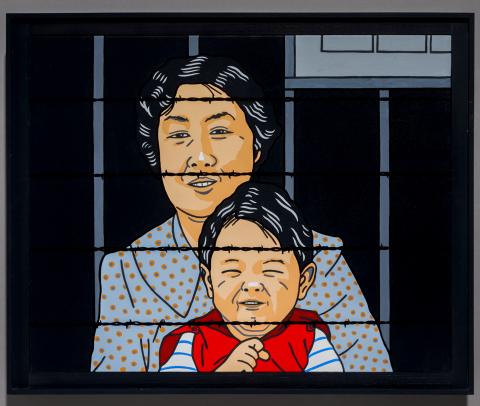
Roger Shimomura: From Studio Art to Performance Art Ace
Roger Shimomura, distinguished painter, printmaker and venerable educator, illuminates his uniquely American story of cultural difference in “Staging Shimomura,” a retrospective look at his lesser known performance art works, primarily from the peak home video era of the 1980s and 90s.
The exhibit at the Spencer Museum of Art is a gleaming example of the importance of the archive in exhibition making. From the diaries of the artist’s grandmother to videotapes of his performances, the events and constructions of the past provide rich source material for “Staging Shimomura,” organized by Kris Ercums, the Spencer’s curator of global contemporary and Asian art.
Curated excerpts of several video-documented performances in all their lo-res glory are greatly enriched by ephemera, including scripts, programs, costumes, masks, production props and photographs. Interesting and relevant inclusions from the Spencer’s permanent collection provide insight and historical context about everything from Japanese printmaking styles to 1960s Pop Art to Shimomura’s collaborations at the University of Kansas.
Several striking two-dimensional works on display demonstrate how Shimomura’s key themes link to and expand across artistic media. We see how the artist shifted from studio artist to interdisciplinary collaborator, experimenting with hybrid art forms bridging cultures and history — traditional Kabuki theater meets unruly contemporary performance art.
Much of the work stems from one vital archival source: decades of diaries written by the artist’s grandmother, Toku Machida Shimomura (1888-1968), from before, during and after her extended family’s incarceration in a Japanese American internment camp during World War II. Toku immigrated to Seattle in 1912 as a young bride and became an important member of the Japanese American community as a midwife and nurse. Her diaries, like her grandson’s visual art, communicate painful and forgotten moments of American history, memories distilled through the sharp lens of cultural difference and shared sameness.
“It started in 1984 when I got my first video camera,” Shimomura explained in a 1996 lecture about his performance-based work. His new artistic tool/toy soon led to the coming out party for his mature performance art phase. Appropriately displayed on a small VHS monitor, “Toku’s Dance” was first performed in October of 1984 at a gallery in Lawrence, Kansas.
Driven by a funky proto-hip-hop dance soundtrack with Kabuki musical accents, the piece was choreographed and performed by Marsha Paludan, one of Shimomura’s most important collaborators, who animated and interpreted Toku as a recurring character. Here, dancing dissonantly in traditional kimono and mask, she cuts a contemporary figure silhouetted behind a Japanese Shōji screen. This mash-up of traditional Japanese culture with freestyle American pop culture is emblematic of Shimomura’s artistic practice as a “Sansei,” or third-generation Japanese American preoccupied with the politics of identity.
Shimomura ventured into full blown theatrical performance with the “The Seven Kabuki Plays Project” (1985-1987). Again working with Paludan and electronic music composer Jim Springer, Shimomura staged several dramatic moments from Toku’s 50 years as diarist.
In an excerpt from Act I we see Toku dressed in kimono and mask on a spare stage with a window and a tabletop radio. In the slow, stylized gestures of Japanese theater, we sense Toku’s surprise, anxiety and fear as she takes in the live radio broadcast of Franklin Delano Roosevelt’s famous statement on the Japanese attack of Pearl Harbor, “A date which will live in infamy.”
The martial synth soundtrack mixes in vocoder altered recordings of Toku’s actual voice. Through the stage window, a grim-faced Superman figure towers 20 feet above the stage, a proxy of American vengeance. The scene closes with Toku posed in silhouette next to a Christian cross suggesting a symbolic trial of faith.
Near the projected performance video is the 1983 acrylic on canvas source painting “Diary: Dec. 7, 1941 (Version #3),” in which Toku listens apprehensively to news about the attack on Pearl Harbor. Though expertly painted in the Japanese ukiyo-e style with strongly delineated forms and dense graphical composition filled with color and patterns, it feels quite frozen in comparison to the expanded time-based media articulated in the “Seven Kabuki Plays.”
We get a further sense of Shimomura’s stagecraft with a high-on-the-wall display of six kimonos used in the project flanked by the daunting Superman prop complete with scarlet cape, a favorite Pop Art subject of the artist. One can imagine how liberating it was for Shimomura the painter/printmaker to break out of pictorial space into the third and fourth dimensions of space and time to express his concepts and narratives in new ways.

